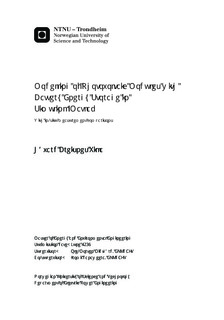| dc.contributor.advisor | Midtgård, Ole-Morten | nb_NO |
| dc.contributor.advisor | Ranaweera, Iromi | nb_NO |
| dc.contributor.author | Vika, Håvard Breisnes | nb_NO |
| dc.date.accessioned | 2014-12-19T13:55:26Z | |
| dc.date.available | 2014-12-19T13:55:26Z | |
| dc.date.created | 2014-09-06 | nb_NO |
| dc.date.issued | 2014 | nb_NO |
| dc.identifier | 744162 | nb_NO |
| dc.identifier | ntnudaim:11924 | nb_NO |
| dc.identifier.uri | http://hdl.handle.net/11250/257839 | |
| dc.description.abstract | The use of renewable energy sources is increasing and will play an important role in the future power systems. The unpredictable and fluctuating nature of solar power leads to a need for energy storage as the prevalence increases.A five parameter model of PV modules has been implemented in Simulink/Matlab. The parameters of the model are determined by an approximation method using data sheet values. Inputs to the model include light intensity and ambient temperature. The outputs are any measurements of interests as well as power, cell temperature and voltage. Effects of varying the model parameters are demonstrated. A maximum power point tracking algorithm is used to keep the voltage at the maximum power point at all times.A battery model based on discharge curve fitting is implemented. The model is based on a fundamental battery cell which can be modified to construct many different module configurations. Power smoothing algorithms which average the input over a set time, are used to provide a power reference to the battery system.The PV model power output is compared to in-situ measurements by giving the model inputs of measured irradiance profile and ambient temperature. Measurements of two different days, one with little variation in irradiance and one with a lot of variation, are used to shed light on different effects. The difference between the output of the simulation and the measured values is very small, in the range of a few percent, especially when there is little variation in irradiance. Large peaks in difference are probably caused by the maximum power point tracking not being able to follow rapidly changing conditions.The approximation used in the modelling of cell temperature deviates significantly from the measured cell temperature. This is confirmed as one of the largest causes of deviance by running simulations with actual measured cell temperature.Power smoothing efficiency is demonstrated with different battery module sizes. Changing the power smoothing algorithm parameters to suit the battery capacity is shown to be effective in providing as good smoothing as possible within battery constraints. | nb_NO |
| dc.language | eng | nb_NO |
| dc.publisher | Institutt for elkraftteknikk | nb_NO |
| dc.title | Modelling of Photovoltaic Modules with Battery Energy Storage in Simulink/Matlab: With in-situ measurement comparisons | nb_NO |
| dc.type | Master thesis | nb_NO |
| dc.source.pagenumber | 134 | nb_NO |
| dc.contributor.department | Norges teknisk-naturvitenskapelige universitet, Fakultet for informasjonsteknologi, matematikk og elektroteknikk, Institutt for elkraftteknikk | nb_NO |

